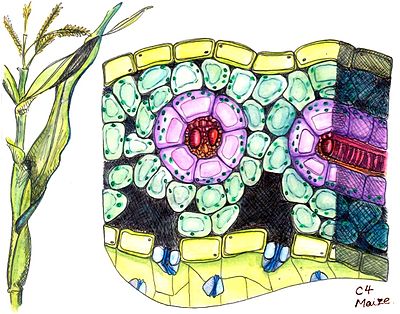C4 Kranz leaf anatomy
he C4 plants often possess a characteristic leaf anatomy called kranz anatomy, from the German word for wreath. Their vascular bundles are surrounded by two rings of cells; the inner ring, called bundle sheath cells, contains starch-rich chloroplastslacking grana, which differ from those in mesophyll cells present as the outer ring. Hence, the chloroplasts are called dimorphic. The primary function of kranz anatomy is to provide a site in which CO2 can be concentrated around RuBisCO, thereby avoiding photorespiration. In order to maintain a significantly higher CO2concentration in the bundle sheath compared to the mesophyll, the boundary layer of the kranz has a low conductance to CO2, a property that may be enhanced by the presence of suberin.[4] The carbon concentration mechanism in C4 plants distinguishes their isotopic signature from other photosynthetic organisms.
Although most C4 plants exhibit kranz anatomy, there are, however, a few species that operate a limited C4cycle without any distinct bundle sheath tissue. Suaeda aralocaspica, Bienertia cycloptera, Bienertia sinuspersici and Bienertia kavirense (all chenopods) are terrestrial plants that inhabit dry, salty depressions in the deserts of the Middle East. These plants have been shown to operate single-cell C4 CO2-concentrating mechanisms, which are unique among the known C4 mechanisms.[5][6][7][8] Although the cytology of both genera differs slightly, the basic principle is that fluid-filled vacuoles are employed to divide the cell into two separate areas. Carboxylation enzymes in the cytosol can, therefore, be kept separate from decarboxylaseenzymes and RuBisCO in the chloroplasts, and a diffusive barrier can be established between the chloroplasts (which contain RuBisCO) and the cytosol. This enables a bundle-sheath-type area and a mesophyll-type area to be established within a single cell. Although this does allow a limited C4 cycle to operate, it is relatively inefficient, with the occurrence of much leakage of CO2 from around RuBisCO. There is also evidence for the exhibiting of inducible C4 photosynthesis by non-kranz aquatic macrophyte Hydrilla verticillata under warm conditions, although the mechanism by which CO2 leakage from around RuBisCO is minimised is currently uncertain.[9]
